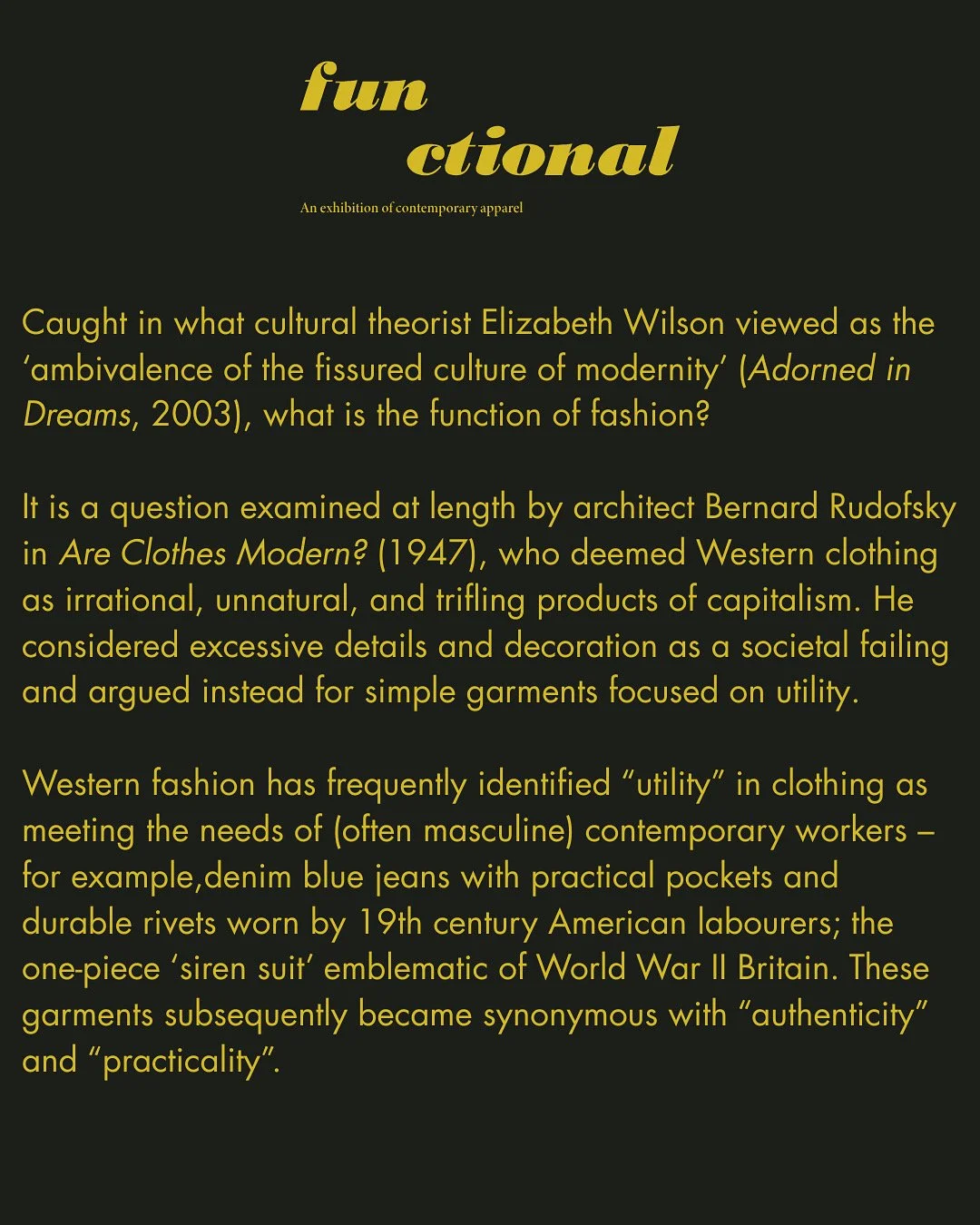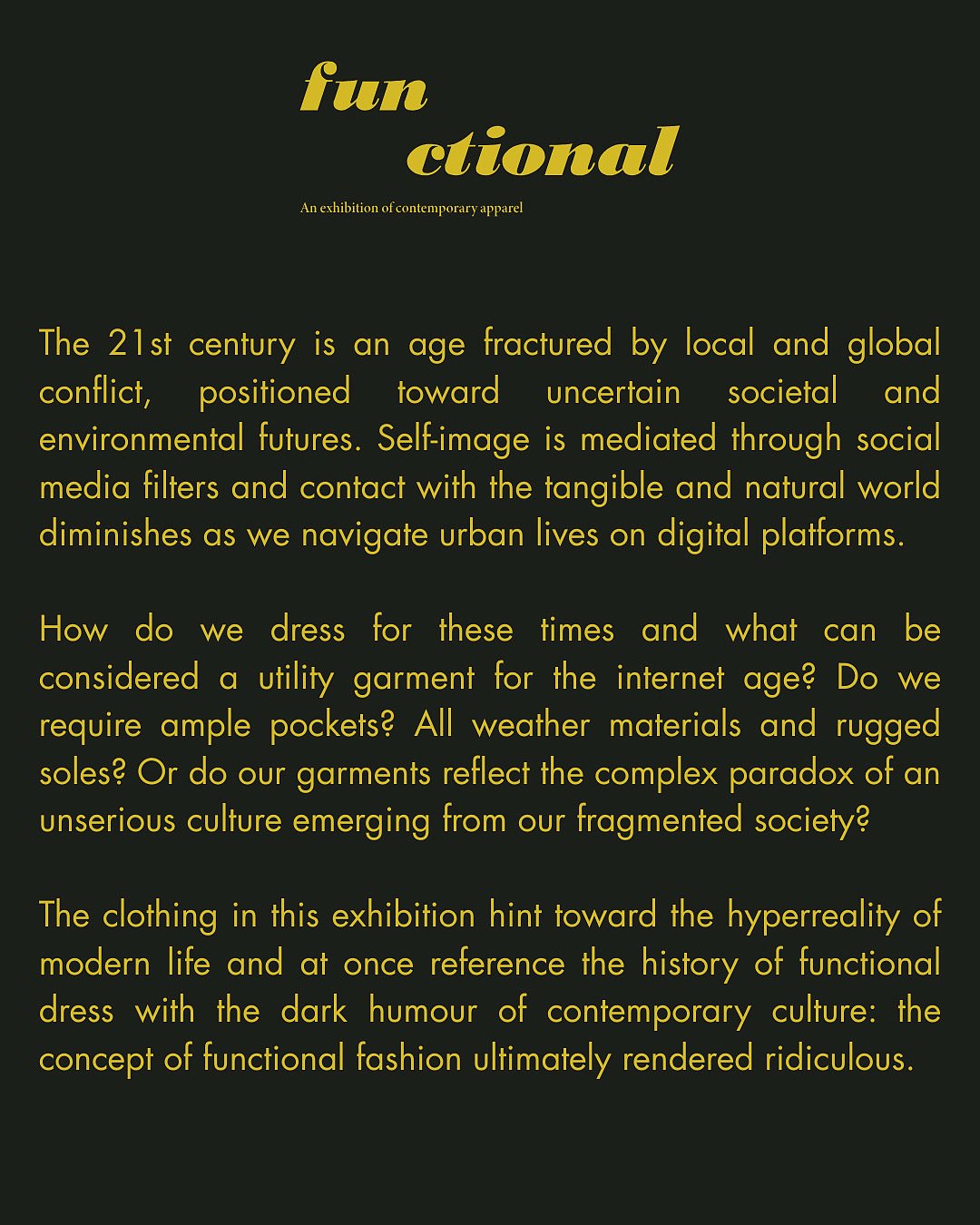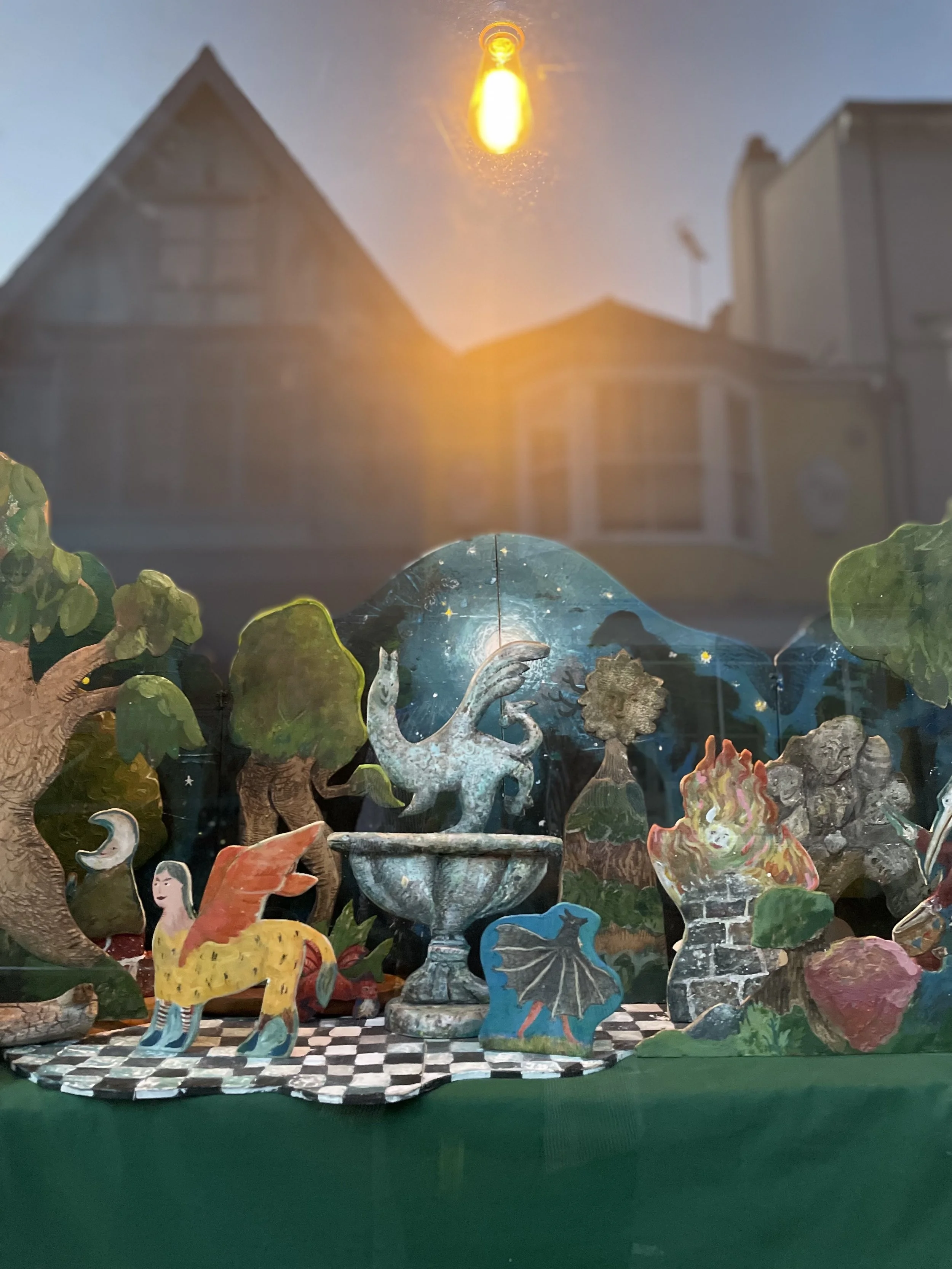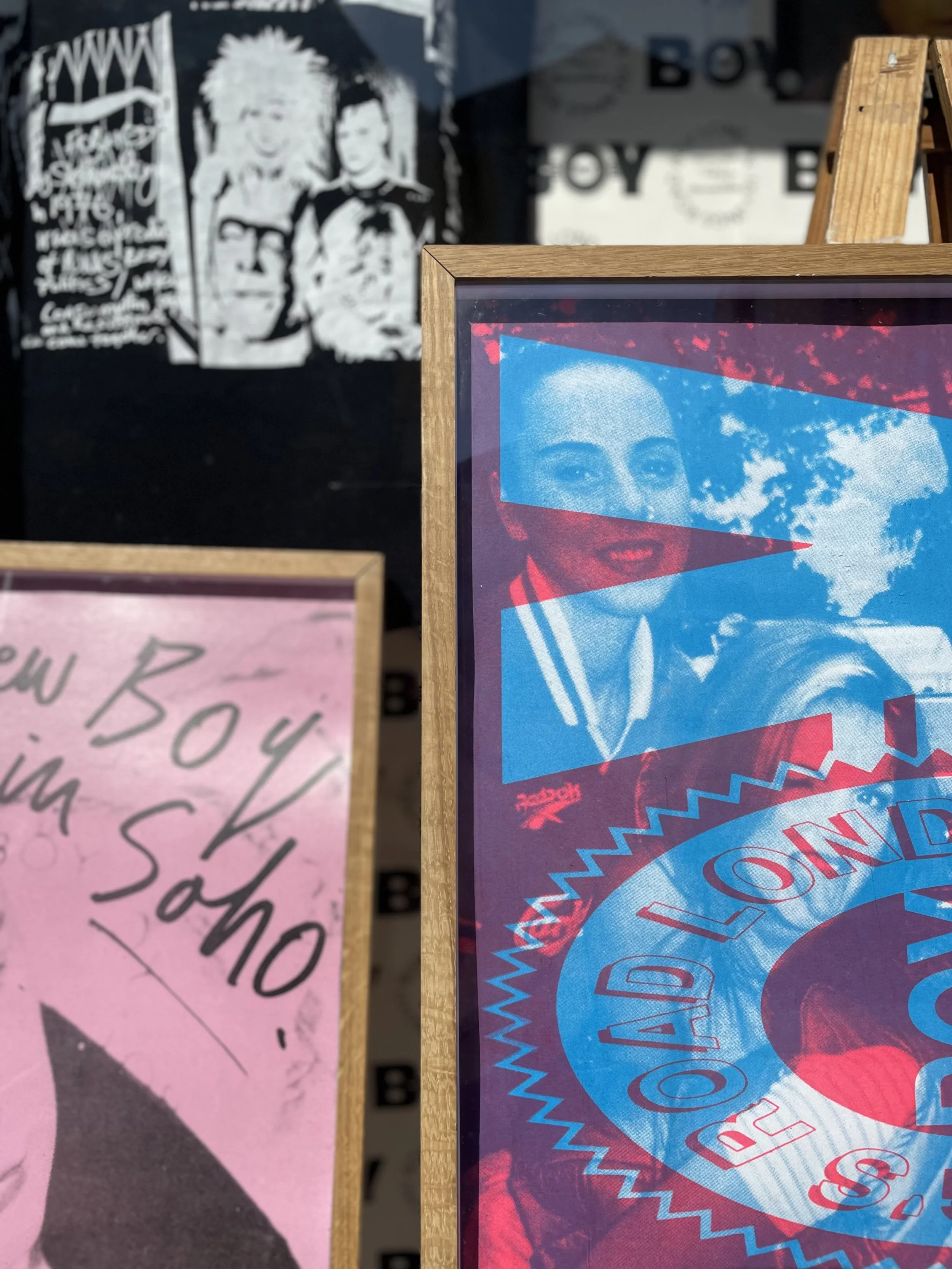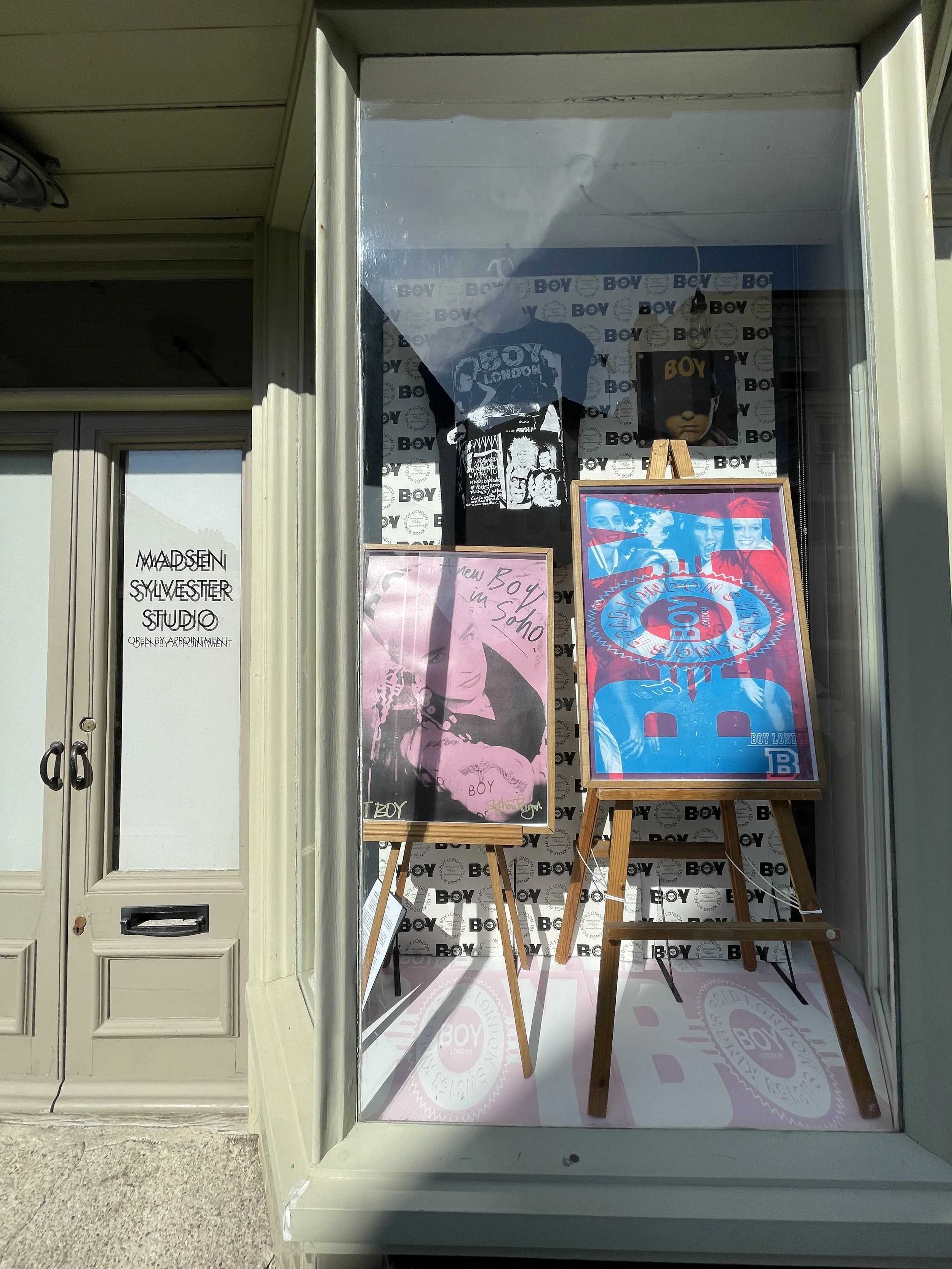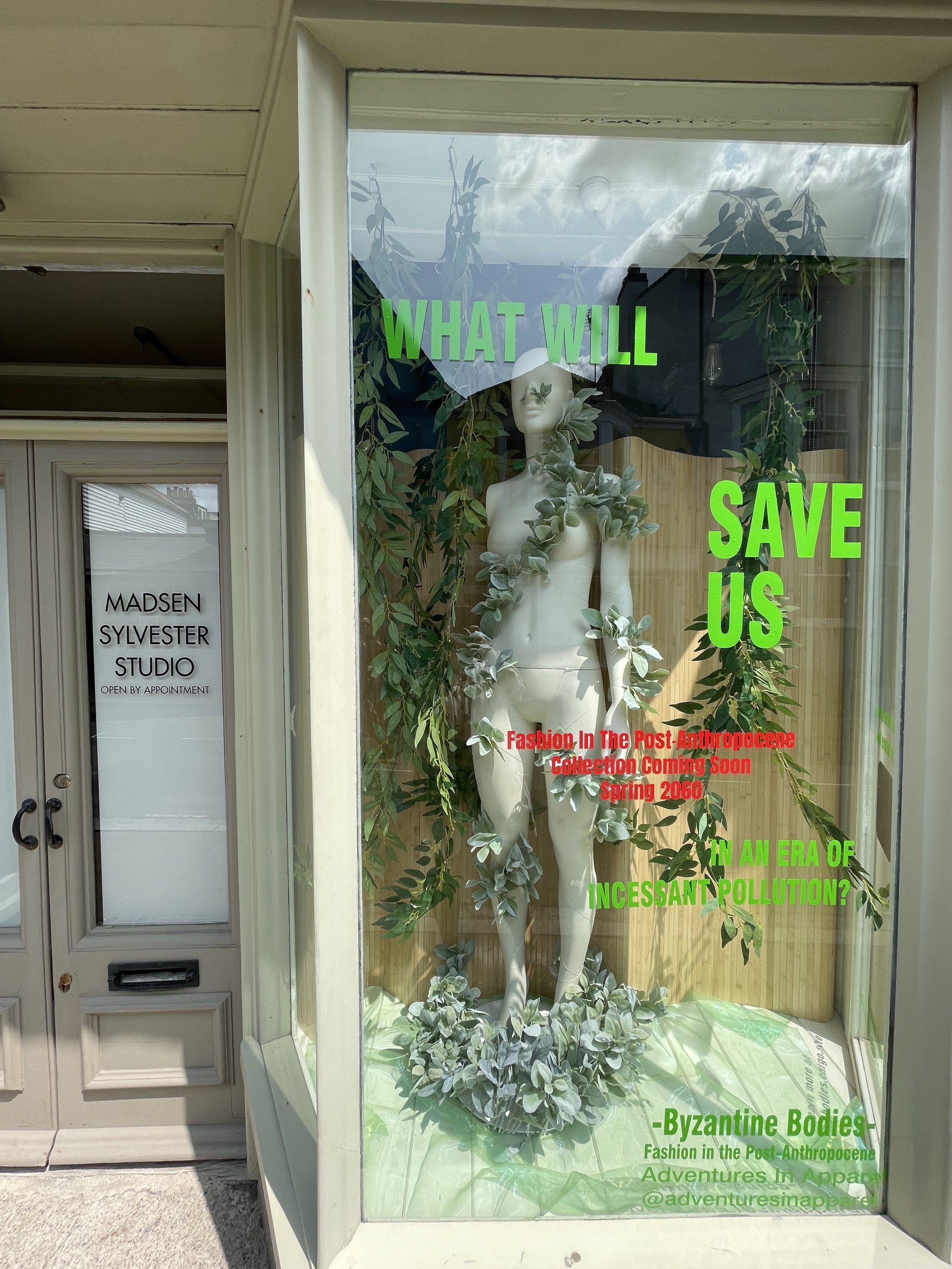Past Exhibitions
Exhibition 10: Fun
ctional
Curator: Cyana Madsen
Date: 24th September - 26th October 2025
fun
ctional
Cyana Madsen, 2025
Exhibition 9: Fayre Revel in the Wode
Artist: Juliana Neufeld
Date: 5th August - 21st August 2025
In the Queer Middle Ages, peasants, nobles, and creatures dance together under the moon...
Fayre Revel in the Wode (2025) was a phantasmagoric scenescape rendered in wood, acrylic, and ink by Canadian illustrator Juliana Neufeld.
This work drew on English folk tales, nature studies, and alternative queer histories to dissolve constructed hierarchies and imagine a siblinghood united through the alchemy of nature, architecture, and costume.
Fayre Revel in the Wode (detail, 2025) © Juliana Neufeld
Fayre Revel in the Wode (detail, 2025) © Juliana Neufeld
Fayre Revel in the Wode (detail, 2025) © Juliana Neufeld
Discover more of Neufeld’s work at juliana-neufeld.com
Exhibition 8: BOYHOOD – The Art Of Stephane Raynor’s BOY
Curator: Jonas Ranson
Date: 30th June - 20th July 2025
BOYHOOD – The Art Of Stephane Raynor’s BOY © Jonas Ranson 2025
‘In the beginning there was BOY’
For over four decades, BOY London has served as a cipher for youth revolt, its identity forged in the crucible of music, thrift culture, and subcultural resistance. At once a reflection and a provocation, BOY’s distinctive graphic language: loud, unapologetic, and often confrontational, emerged from a context as chaotic as it was creatively fertile.
The brand’s founder, Stephane Raynor, was embedded in the very genesis of London’s punk and post-punk milieu. Before BOY, Raynor sold 1950s garments to Malcolm McLaren’s Let It Rock, and later co-founded Acme Attractions, an essential node in London’s early punk network. It was in 1976, however, with the opening of the BOY boutique on King’s Road, that Raynor’s vision fully crystallized.
More than a retail space, BOY was a performance site, a cultural flashpoint. Outside, pavements brimmed with elaborately dressed acolytes; inside, future icons such as Billy Idol manned the till while Philip Salon played host. BOY defined the visual grammar of punk and prefigured the New Romantic aesthetic that followed in its wake.
Critically situated at the intersection of underground authenticity and commercial desirability, BOY was courted by a mainstream eager to appropriate its edge. Its iconography adorned cultural figures as diverse as Andy Warhol, Madonna, and Boy George. From punks to ravers, New Romantics to club kids, BOY’s reach was multigenerational, its stylistic imprint a constant across shifting youth movements. Its longevity is testament to its radical adaptability and enduring cultural relevance.
Raynor’s clientele reads like a who’s who of postwar music and counterculture: Chrissie Hynde, Joe Strummer, John Lydon, Sid Vicious & Bob Marley. The Acme/BOY ecosystem also helped catalyze the careers of acts like Generation X and Chelsea, as well as cultivating a coterie of future creatives, filmmaker Don Letts, Rough Trade’s Jeannette Lee, stylist Eric Rose, and designer Barnzley among others.
In parallel to BOY, Raynor co-founded PX with Roger K. Burton, Ric Carter, and Helen Robinson in Covent Garden, a boutique that functioned as an incubator for the New Romantics. It was here that early appearances from Steve Strange, Princess Julia, Rusty Egan, and a young Boy George signalled a generational shift in aesthetic sensibility. By the late 1980s, Raynor had presciently introduced elements of sportswear into street couture, a move that anticipated future trends in fashion hybridity. BOY boutiques opened in Paris, Los Angeles, and Tokyo, while Raynor himself became a regular at seminal Acid House and rave events across London, Ibiza, and the South of France.
© Jonas Ranson 2025
In 2019, artist and printmaker Jonas Ranson (Instagram @jonasranson.studio) was invited by Raynor to collaborate on a series of silkscreen editions drawn from the designer’s personal archive. At the time, Raynor was running Bad Pharmecy, his final boutique in Hackney. Ranson, who had long admired BOY since his adolescence in the early 1980s, engaged in a series of meetings with Raynor to shape the project’s visual and conceptual trajectory. Their shared affinities, for underground music, DIY publishing, and the visual languages of rebellion, formed the basis for an ambitious collaboration.
Tragically, the project, originally envisioned as a multi-site exhibition and apparel partnership, was derailed by the COVID-19 lockdowns and ultimately curtailed by Raynor’s passing in 2021. The resulting screenprints, all created in close consultation with Raynor and printed at Ranson’s London studio, remained unseen by the public, until now.
Having relocated from East London to Addington Street in Ramsgate in 2022, Ranson identified MADSEN SYLVESTER STUDIO, a space attuned to both the material and cultural resonances of the project, as an ideal venue for an inaugural showing. The imagery, sourced from Raynor’s personal cache of photographs, catalogues, and ephemera, has been reframed through Ranson’s distinct silkscreen methodology, at once archival and reinterpreted.
A graduate of the Royal College of Art (2001–03), Jonas Ranson has pursued a dual practice as an artist and printmaker. His studio, paperHAUS, offers bespoke silkscreen services for artists, musicians, and designers. Past collaborators include Boy George, Daniel Lismore, Mick Jones (The Clash), Ian Anderson (The Designers Republic), culture writer Chris Sullivan, and electronic music pioneers Future Sound of London. His ongoing partnership with Bleep Records and the Farsight Collective continues to explore the interface between visual and sonic experimentation.
This exhibition is not merely a retrospective of unexhibited work. It is a posthumous collaboration, a tribute to Stephane Raynor’s radical imagination, and to BOY’s lasting legacy as a visual language of defiance.
BOYHOOD – The Art Of Stephane Raynor’s BOY © Jonas Ranson 2025
Find out more about Jonas Ranson at ARTBOYX.COM
Exhibition 7: BYZANTINE BODIES: FASHION IN THE POST-ANTHROPOCENE
Curators : Adventures in Apparel
Artists : Yoni Chepisheva, Maricel Reinhard
Date: 8th - 21st June 2025
Byzantine Bodies represents a visual of adaptation and resilience. Here, fashion is not merely decorative but becomes essential for survival. The display presents the "dressed self" of this future — a being whose body is adorned in a skin suit constructed of trichomes from the plant commonyl known as “Lamb’s Ear”. Drawing inspiration from Jemma Battaglia’s Pollutus Planta and the tactile beauty of Stachys Byzantina (commonly known as Lamb’s Ear), our research envisions a speculative reality where humans adapt biologically to protect themselves against emerging environmental pollution through growing their own trichomes (the fuzz on the outside of plant that protects it from environmental pollutants.
The window display offers an experiential element. By scanning the vinyl QR code on the window itself, viewers can interact with the AR element - a web based experience that prompts the viewer to point their phone at their own body. Once they do, it triggers an animation of trichomes growing from their skin and bees pollinating from the viewer’s body. This immerses them into the speculative environment where the viewer's body adapts and becomes resilient to a hostile, byzantine future.
Experience the digital exhibition at https://byzantinebodies.cargo.site
Exhibition 6: COVET: VINTAGE & THE COLLECTOR
Curators: Cyana Madsen and Anthony Sylvester
Date: 28th March - 6th April 2025
Central to anthropologist Igor Kopytoff's paper The Social Life Of Things (1986) is the idea that every object has a life cycle; moving through different social and cultural contexts, gaining new meanings and values as it is used, traded, passed on, forgotten and discarded. While every object is initially created for a specific function, as it interacts with the world, it develops its own narrative, its own biography.
Tangible examples of this biography can be found in collections of vintage clothing. A garment created for a specific purpose may outlive its original utility and find new life in a new environment, under new circumstances. For example, attire designed to be worn by military personnel might be marketed for sale as 'surplus' to be bought and worn by civilian owners far removed from its martial origins.
Senior cords (c. 1966) and pages from Peru Highschool Yearbook, Narcissus (1966)
Collectors on Collecting (Video with English Captions, 4min 49sec)
Jonathan Swanston (Antique Dealer, Kestrel Antiques)
Dr. Sara Idacavage (Fashion Historian, Southern Methodist University)
Ted Allott (Consultant and Archivist, Worne Vintage Clothing)
These trousers originate from the mid 1960s and were made specifically for an alumnus of Peru High School in Indiana, United States of America. It was a state tradition, originating back in 1904 at Perdue University, for students to don 'senior cords' to celebrate their graduation year. Local tailors would make up trousers or skirts of pale yellow or cream cotton corduroy that students would then embellish with drawings of personal motifs and iconography of their favourite subjects, pastimes, and passions: creating a 'wearable yearbook' (Christopher Bernard, New York Times, 2023). The practice was dormant by the end of the 1970s, though its influence can be seen in the output of contemporary American design houses such as Ralph Lauren and Bode.
Senior cords (c.1966)
Despite the hyper-localised (both in geographical and temporal terms) nature of the senior cord tradition, vintage clothing enthusiasts obsess over and trade rare examples as they appear on the market, creating a new audience for the trousers far away from the American Midwest and from the trousers’ original intention and meaning.
The pair on display here are part of the archive collection of studio co-founder Anthony Sylvester and were bought from an East London vintage clothing dealer in 2019. The beige corduroy is embellished with hand drawn marker pen depicting sports team mascots, scholastic topics, and the namesof 1966 class members and teammates. The illustrations on these trousers provide vital clues in identifying the fellow students and faculty members in the text and images, though the name of the original owner and wearer is lost to time.
“The appeal of the ‘Senior cords’ for a clothing collector such as myself is manifold. They represent a great example of classic ‘Ivy League’ Americana that is high on my personal list of items I like to collect. Secondly, they are explicitly linked to the original owner’s biography in a way that is actually tangible and researchable. Corduroy is also a very appealing cloth to me, but most of all, they are entirely unique - there is no other identical pair in existence. If I had passed up the opportunity to pick these up when I did, I doubt another similar pair would ever have crossed my path.” (Anthony Sylvester, 2025)
These senior cord trousers are symbolic not only of the memories of the person who originally modified and wore them but have become recontextualised and are now the coveted possession of a contemporary collector.
Exhibition 5: Jamaica Fashion Guild Ltd: Designing Paradise
Curator: Elli Michaela Young
Date: 23rd February - 2nd March 2025
‘A wise suggestion to the first-time lady visitor is to pack a half filled suitcase, only the barest essentials. She’ll want to take home a variety of sun dresses and original evening gowns styled by the island’s classic designers’ (Brady, 1968)
Jamaica Fashion Guild Ltd: Designing Paradise was curated by academic and creative practitioner Dr Elli Michaela Young. This exhibition showcased the output of designers in the Jamaica Fashion Guild Ltd (JFG) in the context of packing for a Caribbean holiday, and was the first time this rare and unique collection of garments had been publicly exhibited.
Exhibition 4: Enmesh
Curator: Alexia Marmara
Date: 2nd December 2024 - 4th January 2025
"'The Archive is this kind of place that [has] to do with longing and appropriation. It is to do with wanting things that are put together, collected, collated, named in lists and indices; a place where a whole world, a social order, may be imagined by the recurrence of a name in a register, through a scrap of paper, or some other little piece of flotsam.'
- Carolyn Steedman
Personal archives are borderless and unlimited visions of the past and contain invaluable testimonials to the unfixed nature of our worlds. The objects within Enmesh are points of entry into disjointed and hospitable narratives. There is an entrenched connectivity within self and what we encounter through archival objects that opens internal and private passages: a collection of disused cloth, paper or metal becomes a means of constructing and understanding self-hood on top of disused artefacts. Though being surrogates for the vanished past, it is the trust in the beauty and strength of these archives that has enabled a variety of artists and keepers to translate them all into new contexts. Despite its crumbling, shattering or disappearance, the vulnerability of the archival piece finds new power. Through the work of the artists, archivists and fashion designers featured in Enmesh I have traversed the ways in which these virtuosos have enfleshed archives and enmeshed themselves within. Tightly squeezed together and pulsating separately within a small window, consider this a petri dish of precious components of the ever expanding worldwide dust hysteria and archive fever." (Alexia Marmara, 2024)Enmesh (2nd December 2024 - 4th January 2025) was an exhibition exploring evolving negotiations between self and archives, curated by Alexia Marmara (co-curator and co-programmer at The Horse Hospital; previously HYMAG).
You Should Have Been There (Rachelle Francis, 2023)
detail, refurbished found photograph (Chris Neate)
detail, repurposed Victorian linen robe (Indépendantes de Cœur par Valériane Venance)
Exhibition 3: PROTRUSION: a collaboration with the artist Samuel Eyles
Curator: Cyana Madsen
Date: 6th September 2024 - 19th October 2024
In the painting REQUIEM FOR A BROKEN BOWL (2020), one of the most intimate and utilitarian garments, the sport sock, becomes a symbol of self-loathing, indignity, and solitude. In response to this painting by multidisciplinary artist Samuel Eyles, Cyana Madsen curated PROTRUSION: a collaboration with the artist Samuel Eyles (2024).
This installation materialised Eyles' fraught emotional world by producing a series of ribbed cotton talismans to boredom, repetition, and filth. The socks crawled out of the canvas to transform Eyles' symbol of shame into a coveted object which is beautiful, functional, and provides tactile pleasure.
REQUIEM FOR A BROKEN BOWL is not for sale, and Eyles' practice is now focused on writing and filmmaking. Each pair of socks thus became both an essential part of the exhibition design, and an editioned work. Socks were available to purchase through AWMS, and were delivered to owners after the exhibition closed on 19th October 2024. Each pair uniquely reflected the impact of exposure on their colouring and structure: embodying and memorialising the ephemeral nature of practice and display.
In celebration of MADSEN SYLVESTER STUDIO’s first collaborative project, a durational event was held on the evening of Friday, 6th September 2024 and was exhibited until Monday, 9th September 2024. Visitors to the private view of PROTRUSION: a collaboration with the artist Samuel Eyles were invited to contribute a participatory response to Eyles’ painting Iv changed Sam, I wear a hat now (2018). Using discarded glassware they had drunk from, visitors created their own protrusion in the membrane between the world rendered on Eyles’ canvas, and the exhibition space.
Exhibition 2: Curare, or toward a studio ethos
Curator: Cyana Madsen
Date: 28th July 2024 - 4th September 2024
Madsen Sylvester Studio is a space for exhibiting any aspects of the wide remit of the dressed body and fashion, and for interrogating curatorial methods. In establishing the studio and its focus, I decided that while the studio will host curators and support their exhibitions, it will keep no physical collection. This decision has two motivations: dictated by the considerations and capacity of the space, and ideologically motivated by a need to unsettle and question the hierarchies imposed by collecting methodologies.
As a site of experimental praxis, the studio ethos must be explicit in its intention to provide a creative working space to fashion curators. Yet, I acknowledge that this ethos is generated from my own research and experience, and is therefore open to questioning from external practitioners, to ensure its ongoing relevance and utility.
The initial mandate for Madsen Sylvester Studio is that:
· the exhibitions on display at the studio will temporarily highlight a research or personal preoccupation of the specific fashion curator working with the space;
· all visiting curators will be asked to provide a biography which contextualises the exhibition in relation to their practice;
· while at the studio, any objects will be cared for and presented to a standard agreed in dialogue with the visiting curator, the commissioning curator, and any relevant stakeholders;
· the studio will not operate as a permanent site for storing fashion histories.
Curare, or toward a studio ethos thinks about what it means to be a curator without a collection. Is it the location, the objects, or the act that makes us? When not in functional use, the curatorial tools on display: the archive box, acid-free tissue, measuring tape, pencil, nitrile gloves become disembodied objects of dress themselves. Without a collection to document and store, they are both remnants of the performance of collections care, and the materialised symbols of the curator’s implicit promise to care for objects.
Exhibition 1: Introducing the Dressed Self
Curator: Cyana Madsen
Date: 1st July 2024 - 24th July 2024
Introducing the Dressed Self, 2024
“[…]we may take the term 'personal front’ to refer to the other items of expressive equipment, the items that we most intimately identify with the performer himself and that we naturally expect will follow the performer wherever he goes. As part of personal front we may include: insignia of office or rank; clothing[…]”
Erving Goffman, The Presentation of Self in Everyday Life (1956, p. 14)
In his mid-20th century study of human social life, Canadian-American sociologist Erving Goffman proposed that we individuals live our lives in a state of constant performance. To participate in social life we continually perform our version of reality for our audience, the society of observers which surround us, and we perform this reality for ourselves.
White cotton t-shirt with hand drawn self-portrait (c. 1987)
Worn to elementary school, 1987-1988.
An essential aspect of this performance is how we construct and conduct ourselves through our personal appearance, an appearance which includes our clothing. The garments we choose to wear in public, those we don in private at home, and even those that we would never dare to wear in front of even our closest loved ones are all part of this performance of the self.
Black suede block heel shoes with black grosgrain ribbon “Miu Miu” (c. 2014)
Worn on various nights out, 2017 - 2024.
If our clothing informs how we are positioned in the social world and thus how we experience the world around us, it also collects the marks and signs of this experience in its material: the soles of our shoes become worn as we walk through town; our trousers crease around the knees as we move; from our actions in everyday life we get stains, marks, and holes in our clothing.
Black cotton drill boiler suit with metal zipper (c. 2018)
Worn to defend PhD thesis, 2023.
Using items of worn clothing from the collection of curator Cyana Madsen, this installation considers how the clothing of the “Public, Private and Secret” (Eicher, 2020) selves come together to create our social identity, and in the process, collect the memories of our worn experience in the material.
Grishko Pro pointe shoes (c. 2016)
Worn for weekly pointe class, 2016-2017.
Beginning with this exhibition of worn clothing, the vitrine window of Madsen Sylvester Studio will be an experimental site for curators, artists, and researchers to explore all aspects of clothing, the self, and our world through a rotating series of installations and interventions.
Pink velvet slippers embroidered with gold wire lamb of god CMS crest (c. 2018)
Worn constantly, 2018-2024.
Further reading:
Eicher, J. (2020) ‘Dress, the Senses, and Public, Private, and Secret Selves 1’, Fashion Theory, 25(4), pp. 1-21.
Goffman, E. (1956) The Presentation of Self in Everyday Life. University of Edinburgh Social Sciences Research Centre.
Sampson, E. (2020a) Worn: Footwear, Attachment and the Affects of Wear. Bloomsbury Publishing: USA, 2020.
Stone, G. (1995) ‘Appearance and the Self’, in Eicher, J.B., Johnson, K.K.P. and Roach-Higgins, M.E. (eds.) Dress and identity. Reprint. New York: Fairchild Publications, pp. 19-39.
Exhibitions & Workshop.
Ramsgate, UK.
